For the last two months, the Australian labour market has gone backwards. The deterioration seems…
Australian labour market – deteriorating
Today’s release of the – Labour Force data – for September 2014 by the Australian Bureau of Statistics provides a major revision to the data set, which corrects for the extraordinary (and unbelievable) rise in part-time employment and the decline in unemployment that was published in the August release. For more explanation see below. Today’s more realistic results confirm what we have known for some time – the labour market continues to be in a weak state. Total employment fell by 29,700 this month and unemployment rose by 11,000. The rise in unemployment would have been worse had not the participation rate fell by 0.2 percentage points, which just means that hidden unemployment has risen. To complete the story, total hours worked fell by nearly 1 per cent. The revisions to the data confirm that claims last month that the economy was improving and the that the Government’s strategy (what strategy you may ask!) is working are false. The sudden jump in employment published last month was a statistical artifact and has vanished into the reality of the situation.
The summary ABS Labour Force (seasonally adjusted) estimates for September 2014 are:
- Employment decreased 29,700 (0.3 per cent) with full-time employment increasing by 21,600 and part-time employment declining by 51,300.
- Unemployment increased by 11,000 to 746,600.
- The official unemployment rate increased by 0.1 points to 6.1 per cent.
- The participation rate decreased by 0.2 percentage points to 64.5 per cent. It is still well below its November 2010 peak (recent) of 65.9 per cent.
- Aggregate monthly hours worked decreased by 15 million hours (0.9 per cent).
- The quarterly ABS broad labour underutilisation estimates (the sum of unemployment and underemployment) were published in the August release and revised in the September release. Underemployment rose by 0.9 percentage points to 8.5 per cent and total labour underutilisation rate rose sharply to 14.4 per cent. There are now 1,050.1 thousand persons underemployed. Overall, there are 1.796.7 million workers either unemployed or underemployed.
ABS clarifies the nonsensical data for August 2014
Last month, I wrote:
The very strong increase in employment is difficult to believe. To see how much of an outlier it is I produced this graph, which shows the monthly change in part-time employment since February 1978.
Well we now know more.
Yesterday, the Australian Bureau of Statistics (ABS) circulated a press release – ABS to change seasonal adjustment of monthly labour force estimates – which has put the chaotic labour force estimates over the last few months into context.
Effectively, the ABS admitted using seasonal adjustment factors (greater than 1) to adjust the original survey data, when, in fact, they now realise has no seasonality apparent.
Regular readers will immediately recall last months’ estimated rise in employment of 121 thousand and the disbelief that I expressed at the time.
Well the ABS is now saying that the actual estimate is closer to 32 thousand once they adjust for their previous errors.
The ABS are now saying that:
As there is little evidence of seasonality in the July, August and September months for 2014, the ABS has decided that for these months the seasonal factors will be set to one (reflecting no seasonality). This means the seasonally adjusted estimates (other than for the aggregate monthly hours worked series) for these months will be the same as the original series and this will result in revisions to the previously published July and August seasonally adjusted estimates.
The impact of these admissions is as follows. The original (raw) data estimates of the change in total employment from the Labour Force Survey for July and August 2014 are compared to the previously published seasonally adjusted estimates.
| Month | Original (000s) | SA (000s) |
|---|---|---|
| July | -11.9 | -4.1 |
| August | 32.1 | 121.0 |
The following graph shows the difference from the start of 2014. The blue line is the original seasonally adjusted series published as at August 2014, whereas the red line is the revised seasonally adjusted series published today, which the ABS is now saying is more accurate.
You will be unsurprised to know that the ABS has been attacked by a sequence of Federal governments through cuts to its budget. The previous Labor government became totally obsessed with achieving a fiscal surplus despite Australia still be caught up in the crisis and imposed austerity, which included major cuts to the ABS.
They cut surveys, reduced samples and have lost a significant number of its skills statisticians as a result. The press was reporting today that the ABS is also struggling to update its computer systems because of budget cuts.
A victory for mindlessness – again!
Employment growth – negative in September 2014
The revised data in the September release provides a much more accurate picture of what is happening. The July and August data is now heavily adjusted as above.
In the last month, total employment fell by 29,700 (0.3 per cent) with full-time employment increasing by 21,600 and part-time employment falling by 51,300.
Over the last 24 months or so we have seen the labour market data switching back and forth regularly between negative employment growth and positive growth spikes. The revised figures are consistent with that history.
The following graph shows the month by month growth in full-time (blue columns), part-time (grey columns) and total employment (green line) for the 24 months to September 2014 using seasonally adjusted data. It gives you a good impression of just how flat employment growth has been nothwithstanding the huge spike in part-time employment in the August survey, which the revised data shows was substantially offset by the fall in full-time employment.
While full-time and part-time employment growth are fluctuating around the zero line, total employment growth is still well below the growth that was boosted by the fiscal-stimulus in the middle of 2010.
The following table provides an accounting summary of the labour market performance over the last six months. The monthly data is highly variable so this Table provides a longer view which allows for a better assessment of the trends. WAP is working age population (above 15 year olds).
The conclusion – overall there have 34.4 thousand jobs (net) added in Australia over the last six months. Full-time employment has fallen by 2 thousand jobs (net) while part-time work has risen by 36.4 thousand jobs.
The Working Age Population has risen by 168 thousand in the same period while the labour force has risen by 65.6 thousand. The participation rate has fallen by 0.2 percentage points over the last six months.
Employment growth has not been able to keep pace with the underlying population growth and unemployment has risen by 31 thousand as a result.
To put the recent data in perspective, the following graph shows the movement in the labour force and total employment since the low-point unemployment rate month in the last cycle (February 2008) to September 2014. The two series are indexed to 100 at that month. The green line (right-axis) is the gap (plotted against the right-axis) between the two aggregates and measures the change in the unemployment rate since the low-point of the last cycle (when it stood at 4 per cent).
You can see that the labour force index has largely levelled off yet the divergence between it and employment growth has risen sharply (in spurts) over the last several months.
The Gap series gives you a good impression of the asymmetry in unemployment rate responses even when the economy experiences a mild downturn (such as the case in Australia). The unemployment rate jumps quickly but declines slowly.
It also highlights the fact that the recovery has not strong enough to bring the unemployment rate back down to its pre-crisis low. You can see clearly that the unemployment rate fell in late 2009 and then has hovered at the same level for some months before rising again over the last several months.
Since the current government was elected in September 2013, the situation has deteriorated significantly.
The Gap shows that the labour market is now in worse shape than it was at the peak of the financial crisis in 2009. After the government prematurely terminated the fiscal stimulus the situation has progressively deteriorated.
In September 2014, the Gap of 2.4 percentage points and remains above the levels that appeared in May and June 2009 when the Australian economy was enduring the impact of the crisis. All the gains made since then have thus largely disappeared due to poorly crafted fiscal policy not responding appropriately to non-government spending changes.
Today’s results continue to reflect an upward trend in the unemployment rate.
Full-time and Part-time employment in recovery
The following graph shows employment indexes for the last 3 recessions and allows us to see how the trajectory of total employment after each peak prior to the three major recessions in recent history: 1982, 1991 and 2009 (the latter to capture the current episode).
The peak is defined as the month of the low-point unemployment rate in the relevant cycle and total employment was indexed at 100 in each case and then indexed to that base for each of the months as the recession unfolded.
I have plotted the 3 episodes for 79 months after the low-point unemployment rate was reached in each cycle – the length of the current episode.
The initial employment decline was similar for the 1982 and 1991 recessions but the 1991 recovery was delayed by many month and the return to growth much slower than the 1982 recession.
The current episode is distinguished by the lack of a major slump in total employment, which reflects the success of the large fiscal stimulus in 2008 and 2009.
However, the recovery spawned by the stimulus clearly dissipated once the fiscal position was reversed and the economy is now producing very subdued employment outcomes.
Moreover, the current episode is also different to the last two major recessions in the sense that the recovery is over and the economy is deteriorating again.
The next 3-panel graph decomposes the previous graph into full-time and part-time employment. The vertical scales are common to allow a comparison between the three episodes.
First, after the peak is reached, part-time employment continues to increase as firms convert full-time jobs into fractional jobs.
Second, recoveries are dominated by growth in part-time employment as firms are reluctant to commit to more permanent arrangements with workers while there is uncertainty of the future course in aggregate demand.
Third, the current recovery is clearly mediocre by comparison, with both very subdued growth in full-time and part-time work.
Teenage labour market – consistent decline
Teenagers lost 5 thousand jobs overall (net) in September – gaining 2.7 thousand full-time jobs but losing 7.7 thousand part-time jobs net.
The following graph shows the distribution of net employment creation in the last month by full-time/part-time status and age/gender category (15-19 year olds and the rest)
If you take a longer view you see how poor the situation remains.
Over the last 12 months, teenagers have lost 14.3 thousand jobs while the rest of the labour force have gained 136.2 thousand net jobs. Remember that the overall result represents a fairly poor annual growth in employment.
The teenage segment of the labour market is being particularly dragged down by the sluggish employment growth, which is hardly surprising given that the least experienced and/or most disadvantaged (those with disabilities etc) are rationed to the back of the queue by the employers.
The following graph shows the change in aggregates over the last 12 months.
To further emphasise the plight of our teenagers, I compiled the following graph that extends the time period from the February 2008, which was the month when the unemployment rate was at its low point in the last cycle, to the present month (September 2014). So it includes the period of downturn and then the so-called “recovery” period. Note the change in vertical scale compared to the previous two graphs.
Since February 2008, there have been only 945 thousand (net) jobs added to the Australian economy but teenagers have lost a staggering 120.1 thousand over the same period. It is even more stark when you consider that 121.7 thousand full-time teenager jobs have been lost in net terms.
Even in the traditionally, concentrated teenage segment – part-time employment, teenagers have only been able to gain a miserable 1.5 thousand jobs (net) even though 557.1 thousand part-time jobs have been added overall.
Overall, the total employment increase is modest. Further, around 58 per cent of the total (net) jobs added since February 2008 have been part-time, which raises questions about the quality of work that is being generated overall.
To put the teenage employment situation in a scale context the following graph shows the Employment-Population ratios for males, females and total 15-19 year olds since March 2008 (the month which coincided with the low-point unemployment rate of the last cycle).
You can interpret this graph as depicting the loss of employment relative to the underlying population of each cohort. We would expect (at least) that this ratio should be constant if not rising somewhat (depending on school participation rates).
The facts are that the absolute loss of jobs reported above is depicting a disastrous situation for our teenagers. Males, in particular, have lost out severely as a result of the economy being deliberately stifled by austerity policy positions.
The male ratio has fallen by 12.4 percentage points since February 2008, the female by 6.3 percentage points and the overall teenage employment-population ratio has fallen by 9.4 percentage points.
Overall, the performance of the teenage labour market continues to be deeply disturbing. It doesn’t rate much priority in the policy debate, which is surprising given that this is our future workforce in an ageing population. Future productivity growth will determine whether the ageing population enjoys a higher standard of living than now or goes backwards.
The best the Government appears to be capable of is to dream up plans which deny income support to this group and impose impossible activity tests on them.
The longer-run consequences of this teenage “lock out” will be very damaging.
The problem is that in the modest growth period that the Australian labour market enjoyed as a result of the fiscal stimulus and mining investment, teenagers failed to participate in the gains – they went backwards.
It remains that the teenage cohort is not benefiting from the modest growth at present.
I continue to recommend that the Australian government immediately announce a major public sector job creation program aimed at employing all the unemployed 15-19 year olds, who are not in full-time education or a credible apprenticeship program.
The Government should abandon their ideological obsession with supply-side punishment regimes and realise that the unemployed cannot search for jobs that are not there.
It is clear that the Australian labour market continues to fail our 15-19 year olds. At a time when we keep emphasising the future challenges facing the nation in terms of an ageing population and rising dependency ratios the economy still fails to provide enough work (and on-the-job experience) for our teenagers who are our future workforce.
Unemployment – rises by 11,000
The unemployment rate rose by 0.1 percentage points to 6.1 per cent in September 2014 (this was on the revised data). Official unemployment rose by 11,000 to 746,600. The rise would have been much larger had not the participation rate fell (see below).
Overall, the labour market still has significant excess capacity available in most areas and what growth there is is not making any major inroads into the idle pools of labour.
The following graph updates my 3-recessions graph which depicts how quickly the unemployment rose in Australia during each of the three major recessions in recent history: 1982, 1991 and 2009 (the latter to capture the 2008-2010 episode). The unemployment rate was indexed at 100 at its lowest rate before the recession in each case (January 1981; January 1989; May 2008, respectively) and then indexed to that base for each of the months as the recession unfolded.
I have plotted the 3 episodes for 80 months after the low-point unemployment rate was reached in each cycle. The current episode is now in its 80th month (0 being February 2008). For 1991, the peak unemployment which was achieved some 38 months after the downturn began and the resulting recovery was painfully slow. While the 1982 recession was severe the economy and the labour market was recovering by the 26th month. The pace of recovery for the 1982 once it began was faster than the recovery in the current period.
It is significant that the current situation while significantly less severe than the previous recessions is dragging on which is a reflection of the lack of private spending growth and declining public spending growth.
Moreover, the current episode is also different to the last two major recessions in the sense that the recovery is over and the economy is deteriorating again.
In relative terms, the current episode is now worse than the other two recessions (in terms of deviation from low-point unemployment rate).
The graph provides a graphical depiction of the speed at which the recession unfolded (which tells you something about each episode) and the length of time that the labour market deteriorated (expressed in terms of the unemployment rate).
From the start of the downturn to the 80-month point (to September 2014), the official unemployment rate has risen from a base index value of 100 to a value 152.2. After falling steadily as the fiscal stimulus pushed growth along (it reached 122.5 after 35 months – in January 2010), it has been slowly trending up for some months now. Unlike the other episodes, the current trend, at this stage of the cycle, is upwards and accelerating.
It is now above the peak that was reached just before the introduction of the fiscal stimulus. In other words, the gains that emerged in the recovery as a result of the fiscal stimulus in 2009-10 have now been lost.
At 80 months, 1982 index stood at 141.5 (and falling) while the 1991 index was at 145.8. It is clear that at an equivalent point in the “recovery cycle” the current period is more sluggish than our recent two major downturns and trending upwards while the trend in the earlier episodes was moderately downwards.
It now appears that the recoveries have converging, which tells us that the current policy has failed to take advantage of the fact that the latest economic downturn was much more mild than the previous recessions. In other words, the policy failure is locking the economy into a higher unemployment rate than is desirable and otherwise attainable.
Note that these are index numbers and only tell us about the speed of decay rather than levels of unemployment. Clearly the 6.1 per cent at this stage of the downturn is lower that the unemployment rate was in the previous recessions at a comparable point in the cycle although we have to consider the broader measures of labour underutilisation (which include underemployment) before we draw any clear conclusions.
The notable aspect of the current situation is that the recovery is very slow.
Broad labour underutilisation – rises sharply
The ABS published its quarterly broad labour underutilisation measures in the August data release. In the August-quarter, total underemployment rose from 7.6 per cent to 8.5 per cent and the ABS broad labour underutilisation rate rose to 14.5 per cent (the sum of unemployment and underemployment).
| There are now 1,050.1 thousand persons underemployed. Overall, there are 1.796.7 million workers either unemployed or underemployed. |
The following graph plots the history of underemployment in Australia since February 1978.
If hidden unemployment is added to the broad ABS figure the best-case (conservative) scenario would see a underutilisation rate well above 17 per cent at present. Please read my blog – Australian labour underutilisation rate is at least 13.4 per cent – for more discussion on this point.
The next update will be in the November Labour Force data release.
Aggregate participation rate – fell by 0.2 points
The September 2014 participation rate fell by 0.2 points to 64.5 per cent. It remains substantially down on the most recent peak in November 2010 of 65.9 per cent when the labour market was still recovering courtesy of the fiscal stimulus.
In September 2014, negative employment growth (-29,700 net jobs) was below underlying population growth of 0.1 per cent. The Labour Force fell by 0.2 per cent with the decline in participation.
The labour force is a subset of the working-age population (those above 15 years old). The proportion of the working-age population that constitutes the labour force is called the labour force participation rate. Thus changes in the labour force can impact on the official unemployment rate, and, as a result, movements in the latter need to be interpreted carefully. A rising unemployment rate may not indicate a recessing economy.
The labour force can expand as a result of general population growth and/or increases in the labour force participation rates.
In the current month, the unemployment rate rose to 6.1 per cent (0.1 percentage points) but would have been much higher had the participation rate not fallen.
What would have the unemployment rate been had the participation rate not fallen by 0.2 points?
The following Table shows the breakdown in the changes to the main aggregates (Labour Force, Employment and Unemployment) and the impact of the fall in the participation rate.
In September 2014, the loss of 29,700 (net) jobs was accompanied by a labour force decline of 18.7 thousand. As a result, unemployment rose by 11 thousand.
The declining labour force in September 2014 was the outcome of two separate factors:
- The underlying population growth added 16.8 thousand persons to the labour force. The population growth impact on the labour force aggregate is relatively steady from month to month; and
- The fall in the participation rate meant that 35.5 thousand workers left the labour force (relative to what would have occurred had the participation rate remained unchanged).
If the participation rate had not have risen, total unemployment, at the current employment level, would have been 782.1thousand rather than the official count of 746 thousand as recorded by the ABS – a difference of 35.5 thousand workers (the ‘participation effect’).
Thus, without the fall in the participation rate, the unemployment rate would have been 6.3 per cent (rounded) rather than its current value of 6.1 per cent.
The conclusion is that hidden unemployment rose slightly in September 2014.
There is considerable monthly fluctuation in the participation rate but the current rate of 64.5 per cent is a long way below its most recent peak in November 2010 of 65.9 per cent.
What would the unemployment rate be if the participation rate was at that recent November 2010 peak level (65.9 per cent)?
The following graph tells us what would have happened if the participation rate had been constant over the period November 2010 to September 2014. The blue line is the official unemployment since its most recent low-point of 4 per cent in March 2008.
The red line starts at November 2010 (the peak participation month). It is computed by adding the workers that left the labour force as employment growth faltered (and the participation rate fell) back into the labour force and assuming they would have been unemployed. At present, this cohort is likely to comprise a component of the hidden unemployed (or discouraged workers).
Total official unemployment in September 2014 was estimated to be 746.6 thousand. However, if participation had not have fallen since November 2010, there would be 992.3 thousand workers unemployed given growth in population and employment since November 2010.
| The unemployment rate would now be 7.9 per cent if the participation had not fallen below its November 2010 peak of 65.9 per cent. |
The difference between the two numbers mostly reflects the change in hidden unemployment (discouraged workers) since November 2010. These workers would take a job immediately if offered one but have given up looking because there are not enough jobs and as a consequence the ABS classifies them as being Not in the Labour Force.
Note, the gap between the blue and red lines doesn’t sum to total hidden unemployment unless November 2010 was a full employment peak, which it clearly was not. The interpretation of the gap is that it shows the extra hidden unemployed since that time.
Hours worked – fell in September 2014
Aggregate monthly hours worked decreased by 15 million hours (0.9 per cent) in September 2014 in seasonally adjusted terms.
The following graph shows the trend and seasonally adjusted aggregate hours worked indexed to 100 at the peak in February 2008 (which was the low-point unemployment rate in the previous cycle).
The next graph shows the monthly growth (in per cent) over the last 24 months. The dark linear line is a simple regression trend of the monthly change – which depicts a decling trend. You can see the pattern of the change in working hours is also portrayed in the employment graph – zig-zagging across the zero growth line.
Conclusion
In general, we always have to be careful interpreting month to month movements given the way the Labour Force Survey is constructed and implemented.
Last month’s data release (August) also showed how sensitive the data estimates are to the way the statistician collects and adjusts the data for seasonality.
The revelation that the seasonal factors previously applied were wrong (a difference of some 90 thousand estimates jobs) is fairly disturbing and if it is because of budget cuts to the ABS then the Government should make sure they are properly funded and not made to carry the austerity can.
Today’s data release seems to have restored sanity in the time series, in that it confirms the patterns that have been apparent for the last two years.
The labour market is in a poor state and the bias is towards rising unemployment and stagnant employment growth.
The teenage labour market, which is in a parlous state, deteriorated further in September 2014. This is an emergency which is being ignored by the Federal Government.
The neglect of our teenagers will have a very long memory indeed and the negative consequences will be stronger given the ageing population.
That is enough for today!
(c) Copyright 2014 Bill Mitchell. All Rights Reserved.
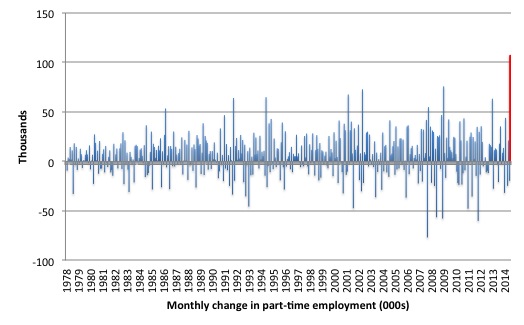
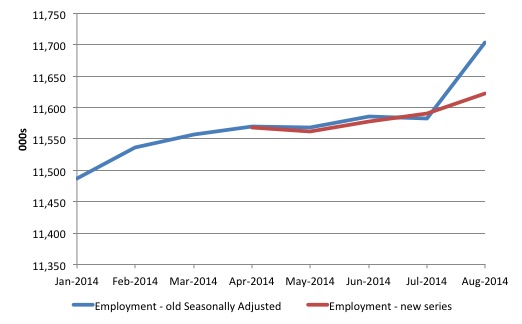
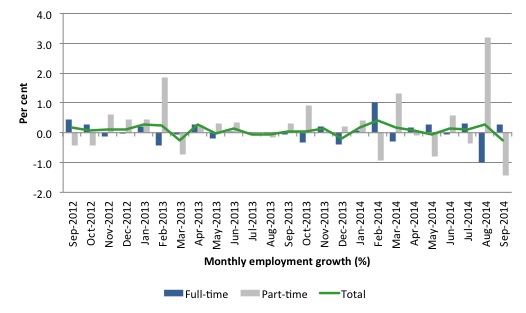
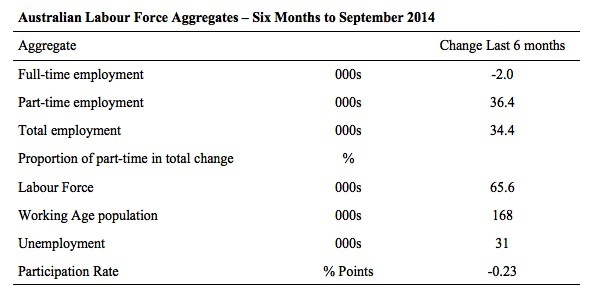
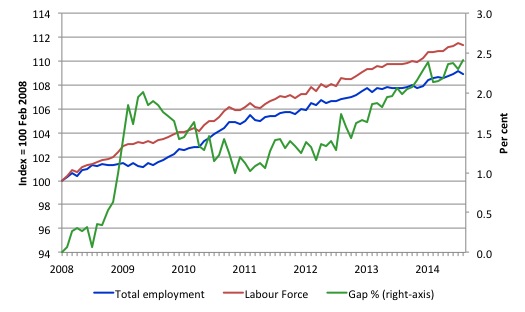
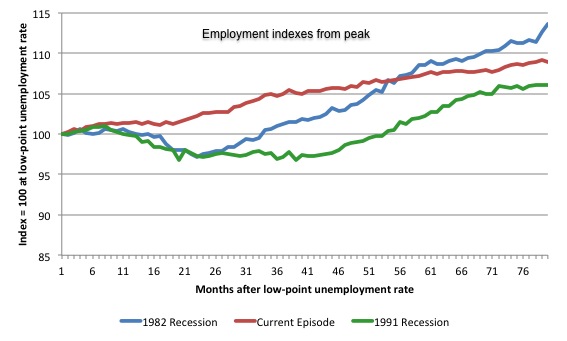

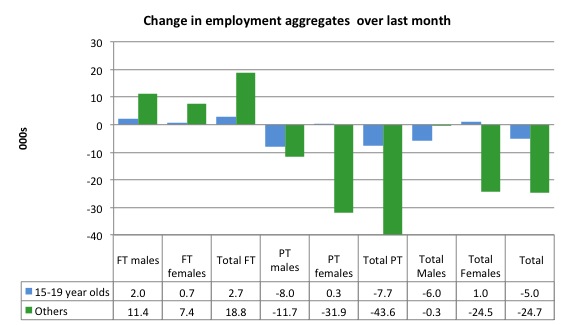
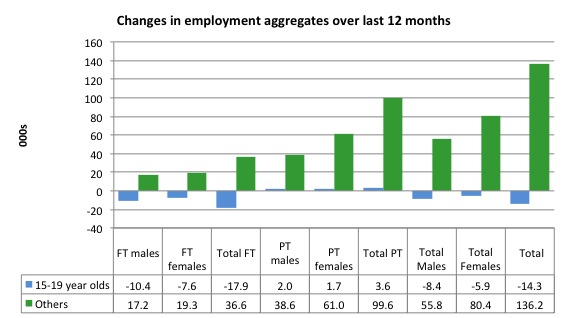
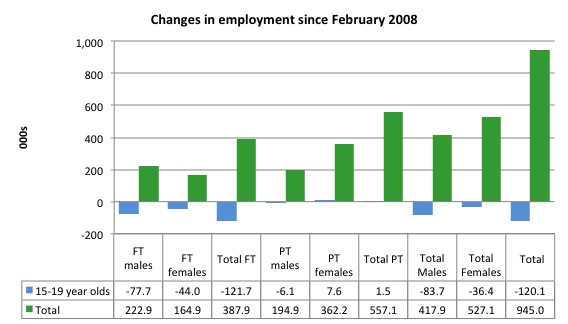
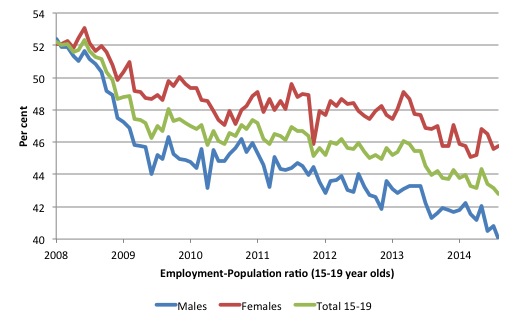
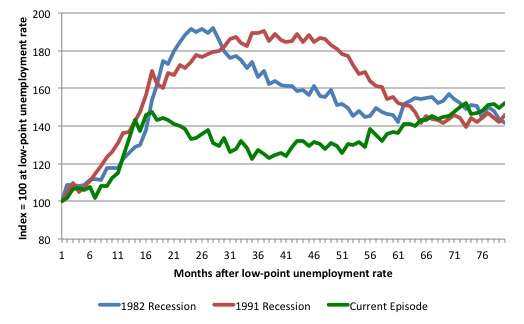
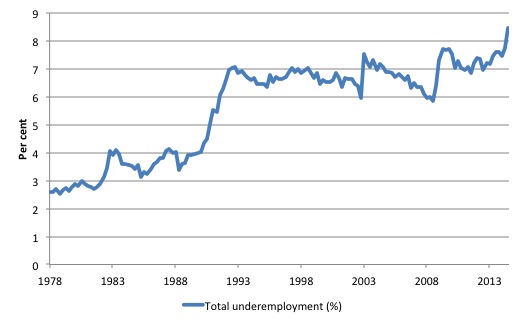
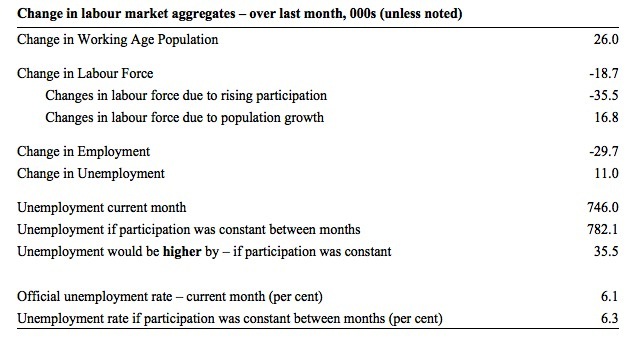
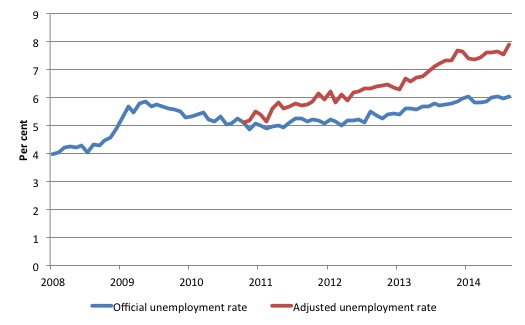
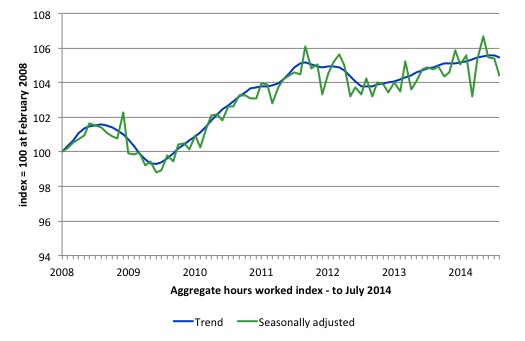
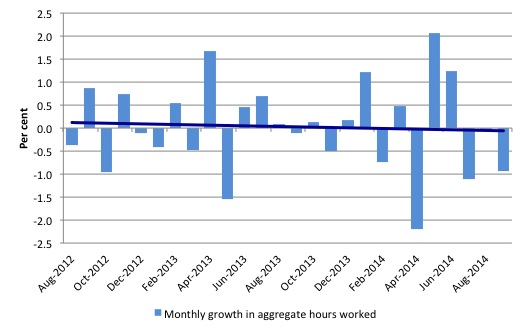
So the original August seasonal factor was around 4 to 1?
Never fear! Our brilliant treasurer has the answer…..
“Treasurer Joe Hockey has signalled that market participants may be charged a fee to access data provided by the Australian Bureau of Statistics (ABS) as he blamed Labor’s budget cuts for dodgy job figures produced by the agency.”
http://www.afr.com/p/national/joe_hockey_proposes_new_tax_to_fix_txhdc87rvf52nACMo0iBTM